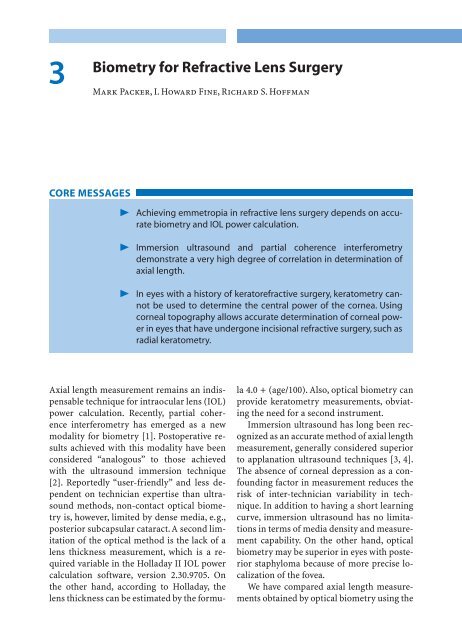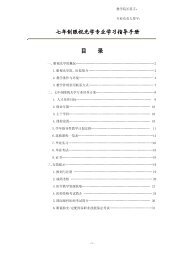Refractive Lens Surgery
Refractive Lens Surgery
Refractive Lens Surgery
Create successful ePaper yourself
Turn your PDF publications into a flip-book with our unique Google optimized e-Paper software.
3<br />
CORE MESSAGES<br />
Biometry for <strong>Refractive</strong> <strong>Lens</strong> <strong>Surgery</strong><br />
Mark Packer, I. Howard Fine, Richard S. Hoffman<br />
2 Achieving emmetropia in refractive lens surgery depends on accurate<br />
biometry and IOL power calculation.<br />
2 Immersion ultrasound and partial coherence interferometry<br />
demonstrate a very high degree of correlation in determination of<br />
axial length.<br />
2 In eyes with a history of keratorefractive surgery, keratometry cannot<br />
be used to determine the central power of the cornea. Using<br />
corneal topography allows accurate determination of corneal power<br />
in eyes that have undergone incisional refractive surgery, such as<br />
radial keratometry.<br />
Axial length measurement remains an indispensable<br />
technique for intraocular lens (IOL)<br />
power calculation. Recently, partial coherence<br />
interferometry has emerged as a new<br />
modality for biometry [1]. Postoperative results<br />
achieved with this modality have been<br />
considered “analogous” to those achieved<br />
with the ultrasound immersion technique<br />
[2]. Reportedly “user-friendly” and less dependent<br />
on technician expertise than ultrasound<br />
methods, non-contact optical biometry<br />
is, however, limited by dense media, e.g.,<br />
posterior subcapsular cataract. A second limitation<br />
of the optical method is the lack of a<br />
lens thickness measurement, which is a required<br />
variable in the Holladay II IOL power<br />
calculation software, version 2.30.9705. On<br />
the other hand, according to Holladay, the<br />
lens thickness can be estimated by the formu-<br />
la 4.0 + (age/100). Also, optical biometry can<br />
provide keratometry measurements, obviating<br />
the need for a second instrument.<br />
Immersion ultrasound has long been recognized<br />
as an accurate method of axial length<br />
measurement, generally considered superior<br />
to applanation ultrasound techniques [3, 4].<br />
The absence of corneal depression as a confounding<br />
factor in measurement reduces the<br />
risk of inter-technician variability in technique.<br />
In addition to having a short learning<br />
curve, immersion ultrasound has no limitations<br />
in terms of media density and measurement<br />
capability. On the other hand, optical<br />
biometry may be superior in eyes with posterior<br />
staphyloma because of more precise localization<br />
of the fovea.<br />
We have compared axial length measurements<br />
obtained by optical biometry using the



